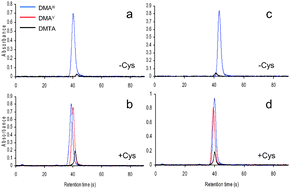Analyses of arsenic (As) species in tissues and body fluids of individuals chronically exposed to inorganic arsenic (iAs) provide essential information about the exposure level and pattern of iAs metabolism. We have previously described an oxidation state-specific analysis of As species in biological matrices by hydride-generation atomic absorption spectrometry (HG-AAS), using cryotrapping (CT) for preconcentration and separation of arsines. To improve performance and detection limits of the method, HG and CT steps are automated and a conventional flame-in-tube atomizer replaced with a recently developed multiple microflame quartz tube atomizer (multiatomizer). In this system, arsines from AsIII-species are generated in a mixture of Tris-HCl (pH 6) and sodium borohydride. For generation of arsines from both AsIII- and AsV-species, samples are pretreated with L-cysteine. Under these conditions, dimethylthioarsinic acid, a newly described metabolite of iAs, does not interfere significantly with detection and quantification of methylated trivalent arsenicals. Analytical performance of the automated HG-CT-AAS was characterized by analyses of cultured cells and mouse tissues that contained mono- and dimethylated metabolites of iAs. The capacity to detect methylated AsIII- and AsV-species was verified, using an in vitromethylation system containing recombinant rat arsenic (+3 oxidation state) methyltransferase and cultured rat hepatocytes treated with iAs. Compared with the previous HG-CT-AAS design, detection limits for iAs and its metabolites have improved significantly with the current system, ranging from 8 to 20 pg. Recoveries of As were between 78 and 117%. The precision of the method was better than 5% for all biological matrices examined. Thus, the automated HG-CT-AAS system provides an effective and sensitive tool for analysis of all major human metabolites of iAs in complex biological matrices.

You have access to this article
 Please wait while we load your content...
Something went wrong. Try again?
Please wait while we load your content...
Something went wrong. Try again?


 Please wait while we load your content...
Please wait while we load your content...